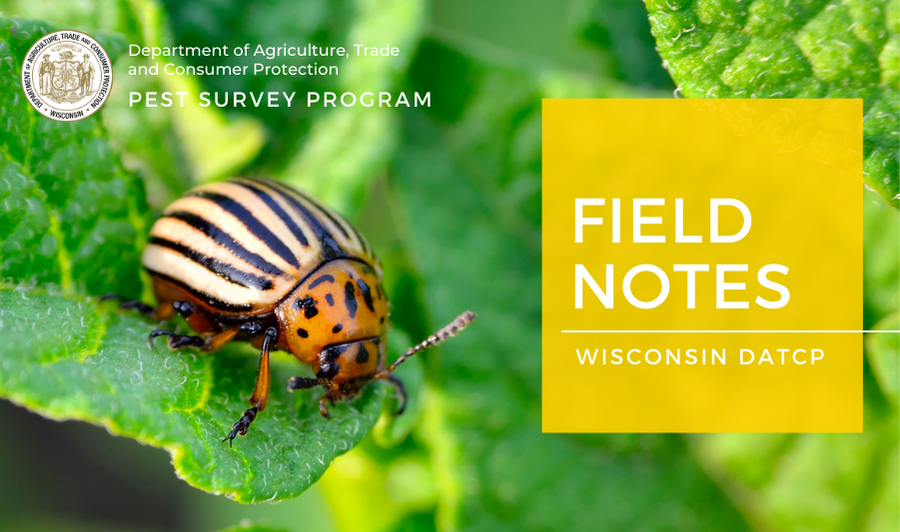|
   A week of warm, mostly dry weather favored fieldwork across Wisconsin. Afternoon high temperatures in the 70s and lower 80s provided a sustained window of opportunity for spring tillage and planting, while improving conditions for emergence of corn, oats, and potatoes.
Crop producers made significant planting gains, though progress statewide remained behind average. According to the USDA National Agricultural Statistics Service (NASS), potato planting was 47 percent complete as of May 8, equal to last year but one day behind the five-year average. Corn planting increased 12 points during the week to 14 percent complete, three days ahead of last year’s pace, but trailing the five-year average by five days.
In southern Wisconsin orchards, most apple tree varieties are in full bloom and pheromone traps have been set in anticipation of the first codling moth flight. Emergence of plum curculio weevils from overwintering sites is also beginning.
__________________________________
|
|
Black cutworm moths arrived in high numbers for the second consecutive week. DATCP’s network of 50 traps collected another 1,027 moths May 5-11, with significant captures of nine or more moths in two nights recorded at 21 sites. The week’s highest count of 143 moths per trap was registered in Rusk County in northwestern Wisconsin.
Egg laying by spring-arriving moths has been underway for 3-4 weeks and some larvae are now in the early instar stages. Signs of cutworm feeding, such as small pinholes in corn leaves, should become noticeable in emerging corn fields next week. Based on forecast predictions for the next 10 days, and using April 17 as the biofix (the date of the first significant moth captures), the projected starting date for the primary black cutworm damage season is May 23 in advanced areas of southern Wisconsin.
In the central and northwest regions of the state, the first major flights were documented on May 2. Corn growers is these areas can anticipate the opening of the peak damage window on May 25 near La Crosse, May 28 at Eau Claire, and June 1 near Hancock.
Severe black cutworm infestations are relatively infrequent in Wisconsin, and several factors must converge to produce outbreaks. Besides weather systems that facilitate heavy moth migrations into the state, conditions favorable for egg laying and survival of larvae are also required. In most years, spring cutworm problems do not materialize.
DATCP pheromone traps have captured a cumulative total of 1,760 moths (average of 35 per trap) since traps were set on April 1. Last season at this time, the count was much lower at 469 moths. Scouting for early black cutworm injury can be combined with stand evaluations and is recommended for corn from emergence through the five-leaf (V5) stage. |
|
 __________________________________
|
|
Evening temperatures and weather conditions may be suitable for codling moth flight over the weekend of May 12-14. Apple growers are advised to begin more frequent trap checks to determine the date of the first catch.
The first flight customarily begins in Wisconsin around petal fall or between 175-250 degree days (simple base 50ºF). According to the simple 50ºF column in the degree day table, the lower range of this threshold has been surpassed in parts of southern and west-central Wisconsin. As a reminder, codling moth pheromone traps should be hung in the upper third of the tree canopy. The standard codling moth lures provided by DATCP need to be replaced after 3-4 weeks.
In addition to the codling moth, another orchard pest that resumes activity between bloom and petal fall is the plum curculio. Emergence of adult weevils from overwintering sites and movement into the perimeter of the orchard occurs on warm evenings when temperatures exceed 60°F. Monitoring for plum curculio is recommended beginning at petal fall.
Reports from our apple insect monitoring network indicate the earliest redbanded leafroller moths began appearing in traps by mid-April. The first flight is now increasing at most monitoring sites, as evidenced by moderate counts ranging from 0-112 moths (average of 54 per trap). With egg laying well underway, early signs of feeding by small leafroller larvae and other lepidopteran species (i.e., green fruitworm, spring cankerworm), should become evident within the next two weeks. Scouting for first and second-instar larvae, while they are actively feeding on leaf tissue, is the only reliable way to determine the need for management of spring lepidopterans at petal fall. Insecticides should not be used until early feeding has been verified through scouting. |
|
 __________________________________
|
|
|
|